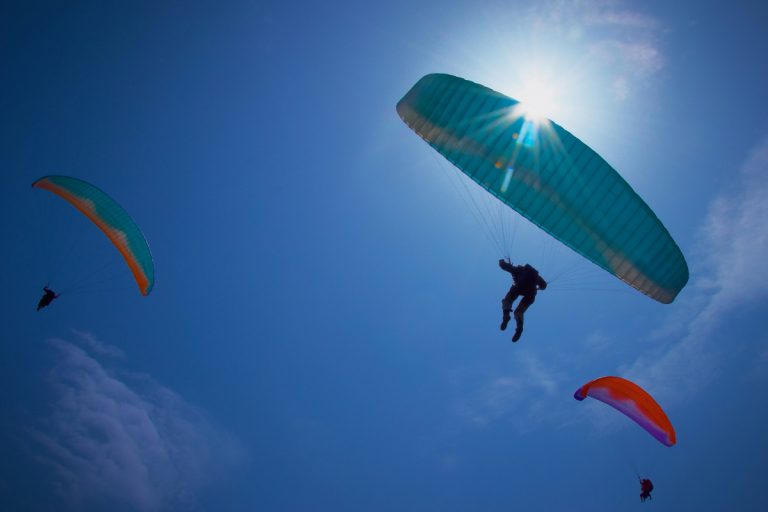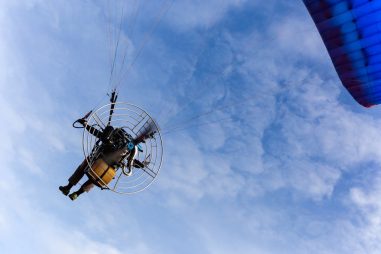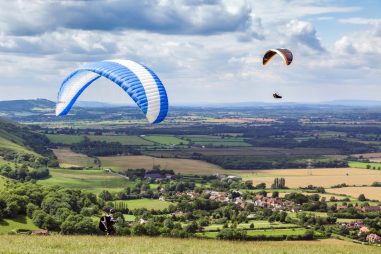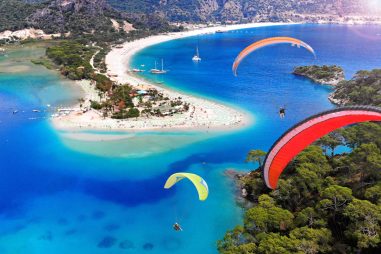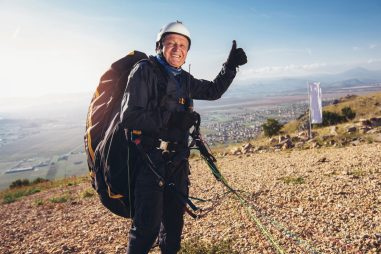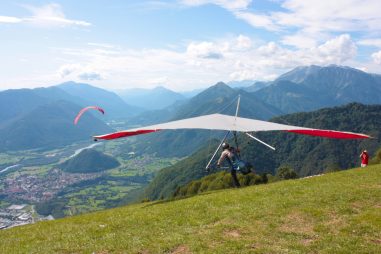Paragliding only has the wings to fly and depends on the wind or thermals to keep it aloft. A drop in the wind or if thermal activity stops can cause the wing to collapse and bring the rider down with it.
While paragliding needs the wind, paramotorists dislike it as it presents a threat to them if strong enough. Other paramotoring dangers include engine failure, getting your lines caught in the propeller, or getting a body part caught in the propeller.
What Is the Difference Between Paragliding and Paramotoring?
Obviously, the motor is the main difference between paramotoring and paragliding. The motor is the key to paramotoring and finding a more accessible launching site to make launches easier. It also allows you to gain elevation and momentum without waiting for a suitable wind. Paramotors do not depend on the wind or thermal current to fly. In fact, not having any wind when paramotoring is ideal.
On the other hand, paragliders need a brisk wind to launch and soar. Therefore, paragliding is wholly dependent on the weather. It requires a good, strong wind and thermals to function. Due to the weather factors, paramotoring is done during the early morning or late afternoon when the weather is cooler. Paragliding is performed later in the morning to midafternoon when thermals are present.
What Is Safer – Paragliding or Paramotoring?
Reported statistics show that paragliding has double the mortality rate of paramotoring. Paragliding accidents have an annual fatality rate of 0.13%, while paramotoring accidents have 0.066%. Compared to motorcycle accidents (0.072%) and car accidents (0.97%), paragliding and paramotoring have much lower fatalities. Based on these stats, paramotoring is safer than paragliding.
Launching a paramotor without any wind is possible, while you need a robust wind to launch a paraglider. If the wind doesn’t hold up when you launch with a paraglider, you can get in trouble really fast. Paramotors are not dependent on the wind, so this hazard is eliminated.
The wing is also less prone to collapsing with paramotors due to its steady forward momentum. While with the paraglider, you are dependent on the wind. However, these are not reasons for complacency when flying with a paramotor. If you are launching and flying in strong wind, the degree of danger is the same for both paraglider and paramotor.
Paraglider vs. Paramotor
Highlighted below are the similarities and the differences between these two exciting sports. You can decide which one is for you.
| Paramotoring | Paragliding |
| It uses a motorized fan to fly | It depends on wind or thermals to fly |
| Flights, when there is no wind, are perfect | It needs wind to fly |
| The best time to fly is during the early morning or late afternoon | The best time to fly is the late morning to early afternoon |
| No need to depend on wind to launch | Will need at least a 3 kph (1.8 mph) wind to take off |
| Can take off from almost anywhere | It needs to take off on from an elevated point |
| Training and learning difficulty is easier than paragliding | Training and learning difficulty is more challenging due to meteorological factor |
| Maintenance cost is higher due to motor | Maintenance cost is minimal |
| The motor will add about 25 kg (55 lbs) to the pilot’s weight | Will need to carry only the pilot |
| More maneuverable due to wing design | Less maneuverable |
| Can travel faster than a paraglider | Travels slower than paramotor |
| You can control about 80% of the flight in paramotoring | You can control about 50% of the flight in paragliding |
| More expensive equipment than paragliding | Cheaper equipment than paramotoring |
| Generally safer than paragliding | More dangerous than paramotoring |
What Is the Difference Between a Paramotor and a Paraglider?
Much has already been discussed about the differences between paragliders and paramotors. Aside from the obvious, there are subtle differences between a paramotor and a paraglider.
A paramotor can stay aloft for about 3.5 hours on a full tank of gas on a calm day. A paraglider has to rely on a consistent wind to stay in flight. Without the right wind conditions, a paraglider cannot fly at all.
Paragliders have to take off from hills and glide down to their landing site. Paramotors can take off from any flat surface free of obstructions. Since they do not depend on the whims of the wind, they can land back from where they started. Doing this saves the rider from a long walk back to their starting point.
Are Paraglider and Paramotor Wings the Same?
No, they are not the same. The wings for paramotoring and paragliding may look similar, but there are a few critical differences.
For example, paragliding wings do not typically have trimmers. Extra lines are used to pull in the wing tips if you want to go faster. However, activating trimmers on a paragliding wing may induce violent whipping motions in the air, which a novice may find hard to control.
Using trimmers in paramotoring will be less risky. The trimmers can also increase the weight the wing can carry, which is important since the paramotor wing must carry the motor and the pilot as well.
There are other imperceptible differences between the two types of wings. The position of the wings relative to the pilot is also a little different to take into account the different weight distribution.
Can I Use a Paraglider Wing for Paramotor?
The short and sweet answer is a definite maybe. The paragliding wing is designed to carry only the pilot, while the paramotor wing is supposed to carry the motor as well.
When a paragliding wing is forced to fly a pilot and the motor, accidents could occur. The weight distribution and the position of the wing relative to the rider will be altered. This could cause problems, especially if the pilot is inexperienced.
However, experienced pilots have used the paraglider wing for paramotoring. Though they wouldn’t recommend it unless you know what you are doing. It’s definitely not for everybody.
It’s infinitely better to use the paragliding wing for its main purpose, which is paragliding. This will keep you out of trouble, and you get to enjoy the sport more.
Can I Use a Paramotor Wing for Paragliding?
Actually, you can (unsatisfyingly) use a paramotor wing for paragliding. But you may not enjoy it as much as using the wing designed for that particular sport. Moreover, the wings will not do an excellent job at each other’s sport. They are designed to do different things, and it’s better not to use one for the other if you can avoid it.
Without getting too technical, let’s say that paraglider wings are not that suitable for paramotoring. Paramotoring wings are not suited for free flight. Their wing profiles are different as they are asked to do different things.
Hybrid or universal wings are supposed to be suitable for both, but they cannot do both proficiently, a case of a jack-of-all-trades but master of none. If you can afford it, it’s better to get one of each wing. You get a better flight, and it will keep you safer as well.
Which Is Better – Paragliding or Paramotoring?
After all the discussions above, here are the pros and cons of paragliding and paramotoring. Ultimately, your safety will depend on your own vigilance. You cannot be complacent even in what you assume is picture-perfect weather. A sudden gust of wind can throw your day in disarray. So be alert and aware of your surroundings, and may your wings always be full of air.
Paragliding
Pros
- Low weight.
- Cheaper equipment and maintenance.
Cons:
- More dangerous than paramotoring.
- It depends on wind and thermals to fly; therefore unpredictable.
- May have long waiting times before the right wind comes along.
- It needs hills to launch the glider.
- It can’t react quickly if necessary.
Paramotoring
Pros:
- Safer than paragliding.
- Not dependent on the weather to fly.
- It can launch from almost anywhere.
- Flies in calmer weather.
- Wing collapse in sudden weather changes can be avoided.
- Can gain altitude quickly if necessary to gain time to react to emergencies.
- It can stay aloft even with a dead engine.
- More maneuverable.
Cons:
- Expensive equipment and maintenance costs.
- Noisier than paragliding.
- You have to carry the 25 kg (55 lbs) motor on your back.

